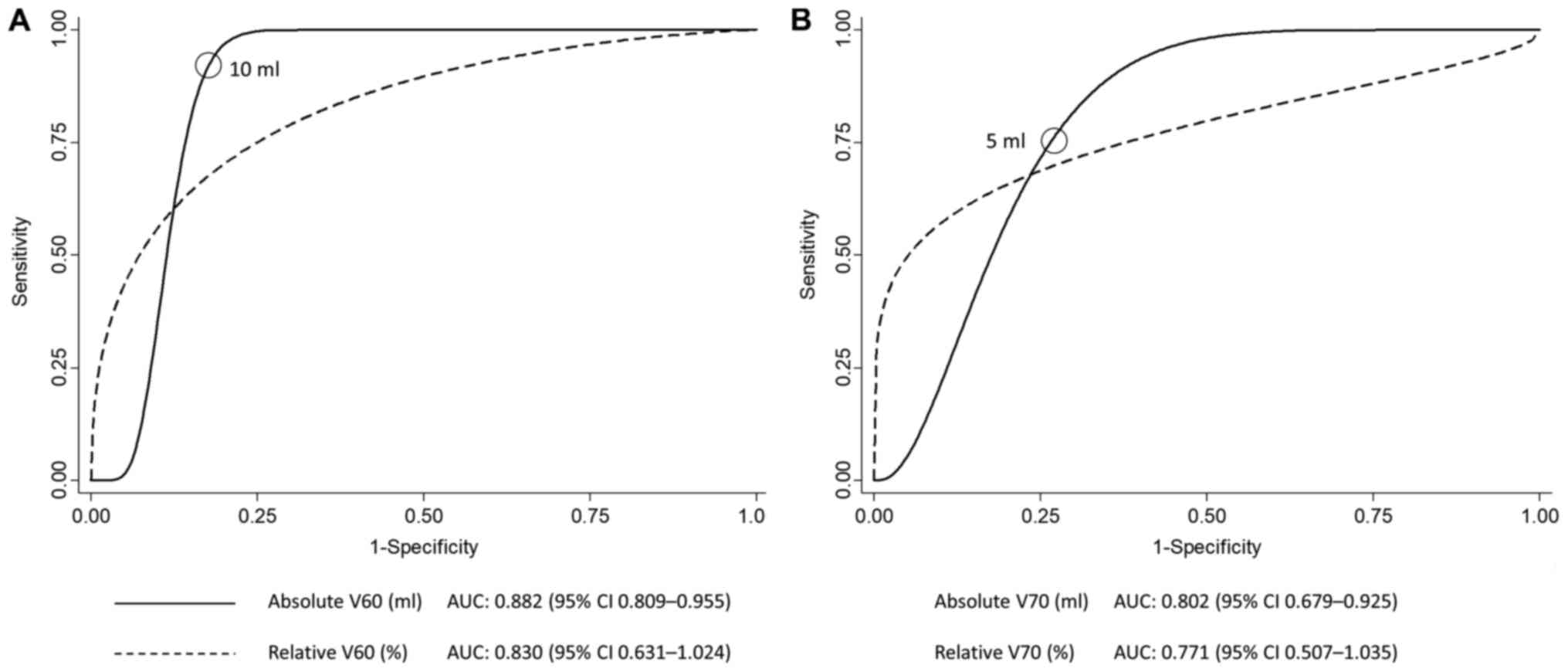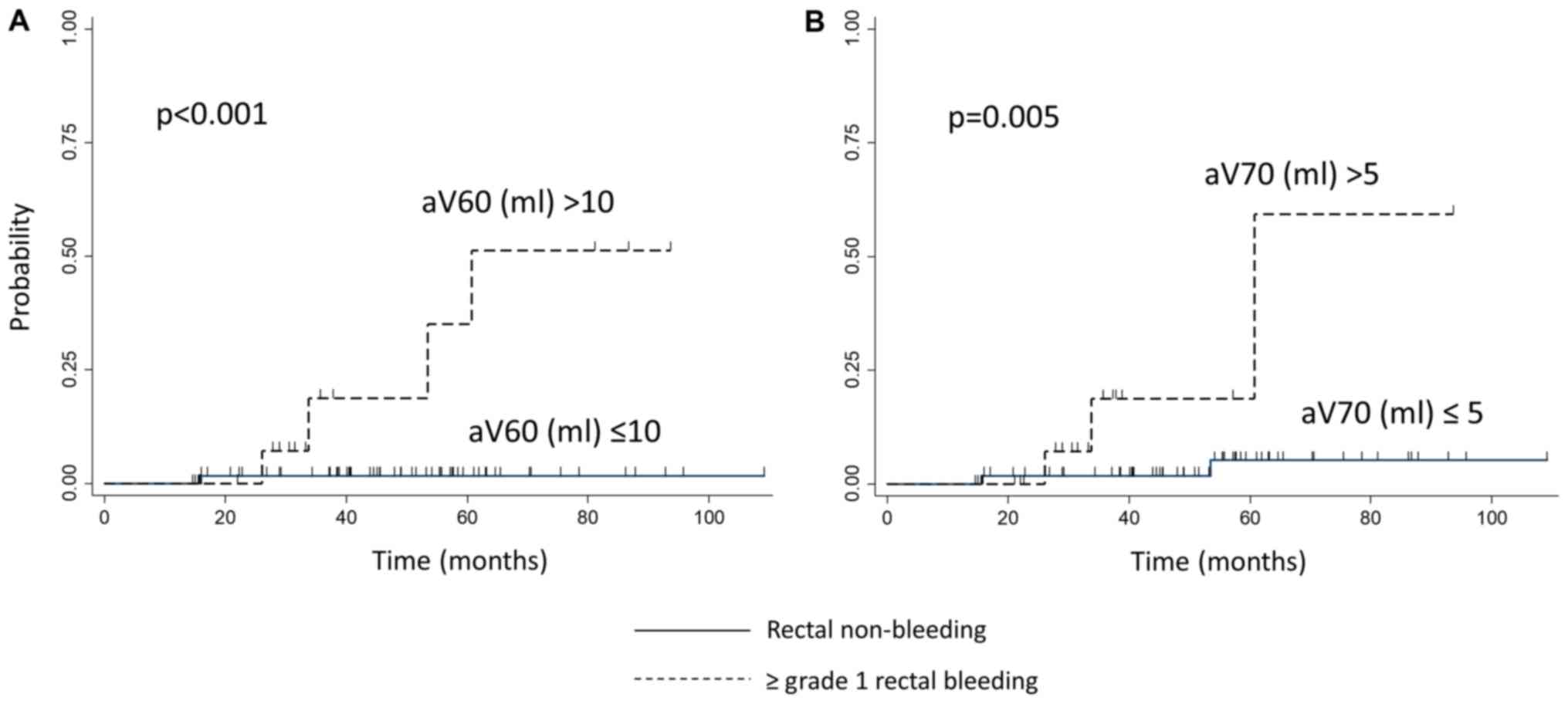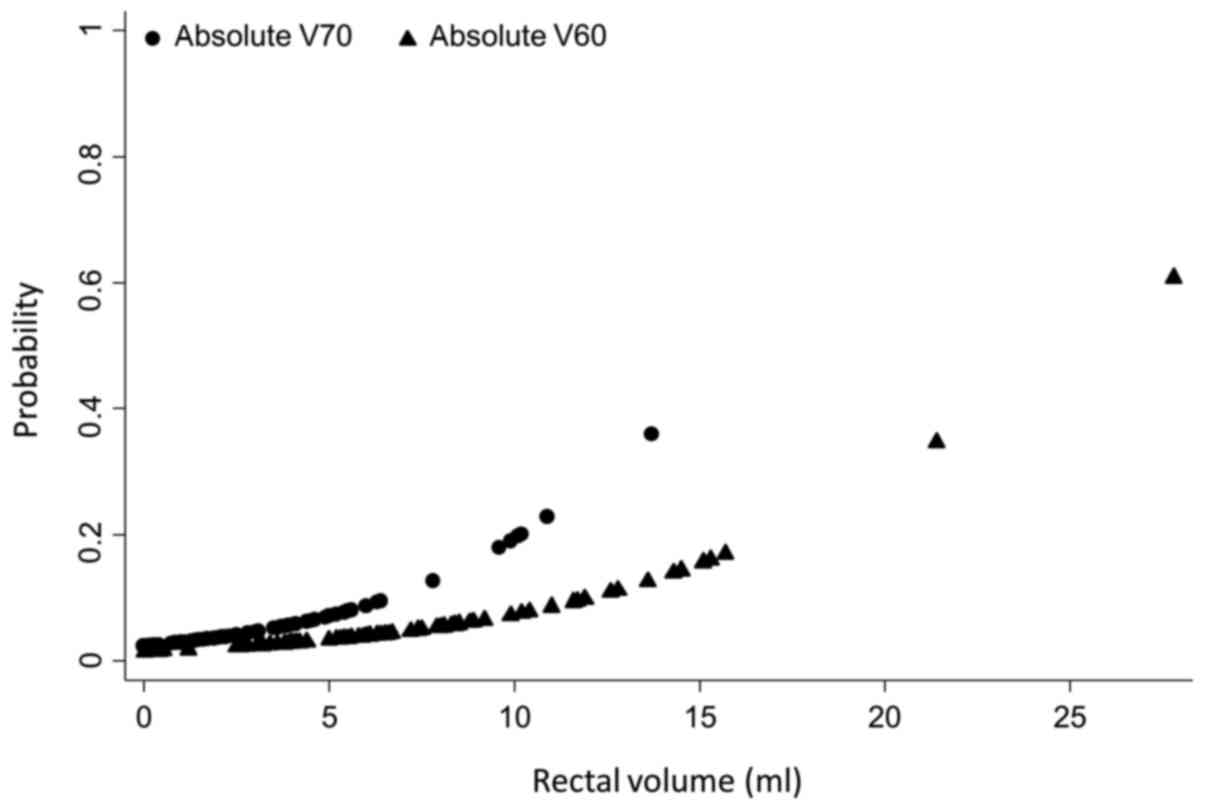|
1
|
Hamdy FC, Donovan JL, Lane JA, Mason M,
Metcalfe C, Holding P, Davis M, Peters TJ, Turner EL, Martin RM, et
al: 10-year outcomes after monitoring, surgery, or radiotherapy for
localized prostate cancer. N Engl J Med. 375:1415–1424. 2016.
View Article : Google Scholar : PubMed/NCBI
|
|
2
|
Kuban DA, Tucker SL, Dong L, Starkschall
G, Huang EH, Cheung MR, Lee AK and Pollack A: Long-term results of
the M. D. Anderson randomized dose-escalation trial for prostate
cancer. Int J Radiat Oncol Biol Phys. 70:67–74. 2008. View Article : Google Scholar
|
|
3
|
Zietman AL, DeSilvio ML, Slater JD, Rossi
CJ Jr, Miller DW, Adams JA and Shipley WU: Comparison of
conventional-dose vs. high-dose conformal radiation therapy in
clinically localized adenocarcinoma of the prostate: A randomized
controlled trial. JAMA. 294:1233–1239. 2005. View Article : Google Scholar : PubMed/NCBI
|
|
4
|
Beckendorf V, Guérif S, Le Prisé E, Cosset
JM, Lefloch O, Chauvet B, Salem N, Chapet O, Bourdin S, Bachaud JM,
et al: The GETUG 70 Gy vs. 80 Gy randomized trial for localized
prostate cancer: Feasibility and acute toxicity. Int J Radiat Oncol
Biol Phys. 60:1056–1065. 2004. View Article : Google Scholar : PubMed/NCBI
|
|
5
|
Dearnaley DP, Sydes MR, Graham JD, Aird
EG, Bottomley D, Cowan RA, Huddart RA, Jose CC, Matthews JH, Millar
J, et al: Escalated-dose versus standard-dose conformal
radiotherapy in prostate cancer: First results from the MRC RT01
randomised controlled trial. Lancet Oncol. 8:475–487. 2007.
View Article : Google Scholar : PubMed/NCBI
|
|
6
|
Peeters ST, Heemsbergen WD, Koper PC, van
Putten WL, Slot A, Dielwart MF, Bonfrer JM, Incrocci L and Lebesque
JV: Dose-response in radiotherapy for localized prostate cancer:
Results of the Dutch multicenter randomized phase III trial
comparing 68 Gy of radiotherapy with 78 Gy. J Clin Oncol.
24:1990–1996. 2006. View Article : Google Scholar : PubMed/NCBI
|
|
7
|
Viani GA, Stefano EJ and Afonso SL:
Higher-than-conventional radiation doses in localized prostate
cancer treatment: A meta-analysis of randomized, controlled trials.
Int J Radiat Oncol Biol Phys. 74:1405–1418. 2009. View Article : Google Scholar : PubMed/NCBI
|
|
8
|
Dearnaley DP, Hall E, Lawrence D, Huddart
RA, Eeles R, Nutting CM, Gadd J, Warrington A, Bidmead M and
Horwich A: Phase III pilot study of dose escalation using conformal
radiotherapy in prostate cancer: PSA control and side effects. Br J
Cancer. 92:488–498. 2005. View Article : Google Scholar : PubMed/NCBI
|
|
9
|
Spratt DE, Pei X, Yamada J, Kollmeier MA,
Cox B and Zelefsky MJ: Long-term survival and toxicity in patients
treated with high-dose intensity modulated radiation therapy for
localized prostate cancer. Int J Radiat Oncol Biol Phys.
85:686–692. 2013. View Article : Google Scholar : PubMed/NCBI
|
|
10
|
Fonteyne V, Sadeghi S, Ost P,
Vanpachtenbeke F, Vuye P, Lumen N and de Meerleer G: Impact of
changing rectal dose volume parameters over time on late rectal and
urinary toxicity after high-dose intensity-modulated radiotherapy
for prostate cancer: A 10-years single centre experience. Acta
Oncol. 54:854–861. 2015. View Article : Google Scholar : PubMed/NCBI
|
|
11
|
Davis KM, Kelly SP, Luta G, Tomko C,
Miller AB and Taylor KL: The association of long-term
treatment-related side effects with cancer-specific and general
quality of life among prostate cancer survivors. Urology.
84:300–306. 2014. View Article : Google Scholar : PubMed/NCBI
|
|
12
|
Delobel JB, Gnep K, Ospina JD, Beckendorf
V, Chira C, Zhu J, Bossi A, Messai T, Acosta O, Castelli J and de
Crevoisier R: Nomogram to predict rectal toxicity following
prostate cancer radiotherapy. PLoS One. 12:e01798452017. View Article : Google Scholar : PubMed/NCBI
|
|
13
|
Fonteyne V, Ost P, Vanpachtenbeke F,
Colman R, Sadeghi S, Villeirs G, Decaestecker K and de Meerleer G:
Rectal toxicity after intensity modulated radiotherapy for prostate
cancer: Which rectal dose volume constraints should we use?
Radiother Oncol. 113:398–403. 2014. View Article : Google Scholar : PubMed/NCBI
|
|
14
|
Fellin G, Rancati T, Fiorino C, Vavassori
V, Antognoni P, Baccolini M, Bianchi C, Cagna E, Borca VC, Girelli
G, et al: Long term rectal function after high-dose prostatecancer
radiotherapy: Results from a prospective cohort study. Radiother
Oncol. 110:272–277. 2014. View Article : Google Scholar : PubMed/NCBI
|
|
15
|
Pearlstein KA and Chen RC: Comparing
dosimetric, morbidity, quality of life and cancer control outcomes
after 3D conformal, intensity-modulated and proton radiation
therapy for prostate cancer. Semin Radiat Oncol. 23:182–190. 2013.
View Article : Google Scholar : PubMed/NCBI
|
|
16
|
Valdagni R, Kattan MW, Rancati T, Yu C,
Vavassori V, Fellin G, Cagna E, Gabriele P, Mauro FA, Baccolini M,
et al: Is it time to tailor the prediction of radio-induced
toxicity in prostate cancer patients? Building the first set of
nomograms for late rectal syndrome. Int J Radiat Oncol Biol Phys.
82:1957–1966. 2012. View Article : Google Scholar : PubMed/NCBI
|
|
17
|
Pederson AW, Fricano J, Correa D,
Pelizzari CA and Liauw SL: Late toxicity after intensity-modulated
radiation therapy for localized prostate cancer: An exploration of
dose-volume histogram parameters to limit genitourinary and
gastrointestinal toxicity. Int J Radiat Oncol Biol Phys.
82:235–241. 2012. View Article : Google Scholar : PubMed/NCBI
|
|
18
|
Swanson GP and Stathakis S: Rectal dose
constraints for intensity modulated radiation therapy of the
prostate. Am J Clin Oncol. 34:188–195. 2011.PubMed/NCBI
|
|
19
|
Michalski JM, Gay H, Jackson A, Tucker SL
and Deasy JO: Radiation dose-volume effects in radiation-induced
rectal injury. Int J Radiat Oncol Biol Phys. 76(3 Suppl):
S123–S129. 2010. View Article : Google Scholar : PubMed/NCBI
|
|
20
|
Gulliford SL, Foo K, Morgan RC, Aird EG,
Bidmead AM, Critchley H, Evans PM, Gianolini S, Mayles WP, Moore
AR, et al: Dose-volume constraints to reduce rectal side effects
from prostate radiotherapy: Evidence from MRC RT01 trial ISRCTN
47772397. Int J Radiat Oncol Biol Phys. 76:747–754. 2010.
View Article : Google Scholar : PubMed/NCBI
|
|
21
|
D'Amico AV, Whittington R, Malkowicz SB,
Schultz D, Blank K, Broderick GA, Tomaszewski JE, Renshaw AA,
Kaplan I, Beard CJ and Wein A: Biochemical outcome after radical
prostatectomy, external beam radiation therapy, or interstitial
radiation therapy for clinically localized prostate cancer. JAMA.
280:969–974. 1998. View Article : Google Scholar : PubMed/NCBI
|
|
22
|
Fowler JF: The linear-quadratic formula
and progress in fractionated radiotherapy. Br J Radiol. 62:679–694.
1989. View Article : Google Scholar : PubMed/NCBI
|
|
23
|
U.S. Department of Health and Human
Services, National Institutes of Health and National Cancer
Institute: Common Terminology Criteria for Adverse Events (CTCAE).
Version 4.03. https://www.eortc.be/services/doc/ctc/CTCAE_4.03_2010-06-14_QuickReference_5x7.pdfJune
14–2010
|
|
24
|
Kupelian PA, Reddy CA, Carlson TP and
Willoughby TR: Dose/volume relationship of late rectal bleeding
after external beam radiotherapy for localized prostate cancer:
Absolute or relative rectal volume? Cancer J. 8:62–66. 2002.
View Article : Google Scholar : PubMed/NCBI
|
|
25
|
Zelefsky MJ, Kollmeier M, Cox B, Fidaleo
A, Sperling D, Pei X, Carver B, Coleman J, Lovelock M and Hunt M:
Improved clinical outcomes with high-dose image guided radiotherapy
compared with non-IGRT for the treatment of clinically localized
prostate cancer. Int J Radiat Oncol Biol Phys. 84:125–129. 2012.
View Article : Google Scholar : PubMed/NCBI
|
|
26
|
Michalski JM, Winter K, Purdy JA, Wilder
RB, Perez CA, Roach M, Parliament MB, Pollack A, Markoe AM, Harms
W, et al: Preliminary evaluation of low-grade toxicity with
conformal radiation therapy for prostate cancer on RTOG 9406 dose
levels I and II. Int J Radiat Oncol Biol Phys. 56:192–198. 2003.
View Article : Google Scholar : PubMed/NCBI
|
|
27
|
Guckenberger M, Ok S, Polat B, Sweeney RA
and Flentje M: Toxicity after intensity-modulated, image-guided
radiotherapy for prostate cancer. Strahlenther Onkol. 186:535–543.
2010. View Article : Google Scholar : PubMed/NCBI
|
|
28
|
Ghadjar P, Vock J, Vetterli D, Manser P,
Bigler R, Tille J, Madlung A, Behrensmeier F, Mini R and Aebersold
DM: Acute and late toxicity in prostate cancer patients treated by
dose escalated intensity modulated radiation therapy and organ
tracking. Radiat Oncol. 3:352008. View Article : Google Scholar : PubMed/NCBI
|
|
29
|
Lips IM, Dehnad H, van Gils CH, Boeken
Kruger AE, van der Heide UA and van Vulpen M: High-dose
intensity-modulated radiotherapy for prostate cancer using daily
fiducial marker-based position verification: Acute and late
toxicity in 331 patients. Radiat Oncol. 3:152008. View Article : Google Scholar : PubMed/NCBI
|
|
30
|
Chan LW, Xia P, Gottschalk AR, Akazawa M,
Scala M, Pickett B, Hsu IC, Speight J and Roach M III: Proposed
rectal dose constraints for patients undergoing definitive whole
pelvic radiotherapy for clinically localized prostate cancer. Int J
Radiat Oncol Biol Phys. 72:69–77. 2008. View Article : Google Scholar : PubMed/NCBI
|
|
31
|
Vargas C, Martinez A, Kestin LL, Yan D,
Grills I, Brabbins DS, Lockman DM, Liang J, Gustafson GS, Chen PY,
et al: Dose-volume analysis of predictors for chronic rectal
toxicity after treatment of prostate cancer with adaptive
image-guided radiotherapy. Int J Radiat Oncol Biol Phys.
62:1297–1308. 2005. View Article : Google Scholar : PubMed/NCBI
|
|
32
|
Huang EH, Pollack A, Levy L, Starkschall
G, Dong L, Rosen I and Kuban DA: Late rectal toxicity: Dose-volume
effects of conformal radiotherapy for prostate cancer. Int J Radiat
Oncol Biol Phys. 54:1314–1321. 2002. View Article : Google Scholar : PubMed/NCBI
|
|
33
|
Koper PC, Heemsbergen WD, Hoogeman MS,
Jansen PP, Hart GA, Wijnmaalen AJ, van Os M, Boersma LJ, Lebesque
JV and Levendag P: Impact of volume and location of irradiated
rectum wall on rectal blood loss after radiotherapy of prostate
cancer. Int J Radiat Oncol Biol Phys. 58:1072–1082. 2004.
View Article : Google Scholar : PubMed/NCBI
|
|
34
|
Fiorino C, Fellin G, Rancati T, Vavassori
V, Bianchi C, Borca VC, Girelli G, Mapelli M, Menegotti L, Nava S
and Valdagni R: Clinical and dosimetric predictors of late rectal
syndrome after 3D-CRT for localized prostate cancer: Preliminary
results of a multicenter prospective study. Int J Radiat Oncol Biol
Phys. 70:1130–1137. 2008. View Article : Google Scholar : PubMed/NCBI
|
|
35
|
de Crevoisier R, Tucker SL, Dong L, Mohan
R, Cheung R, Cox JD and Kuban DA: Increased risk of biochemical and
local failure in patients with distended rectum on the planning CT
for prostate cancer radiotherapy. Int J Radiat Oncol Biol Phys.
62:965–973. 2005. View Article : Google Scholar : PubMed/NCBI
|
|
36
|
Feigenberg SJ, Hanlon AL, Horwitz EM, Uzzo
RG, Eisenberg D and Pollack A: Long-term androgen deprivation
increases Grade 2 and higher late morbidity in prostate cancer
patients treated with three-dimensional conformal radiation
therapy. Int J Radiat Oncol Biol Phys. 62:397–405. 2005. View Article : Google Scholar : PubMed/NCBI
|












